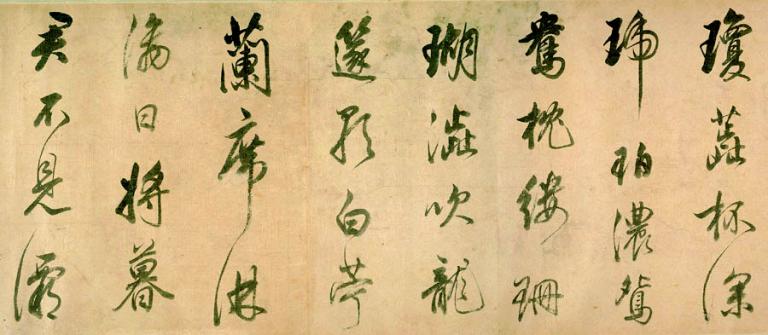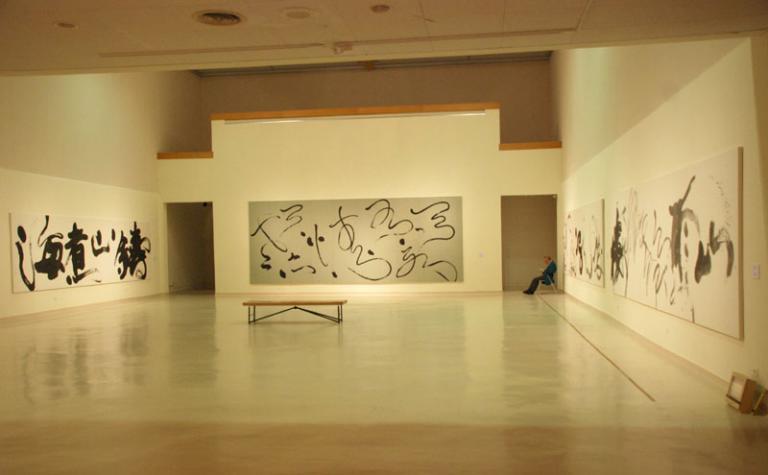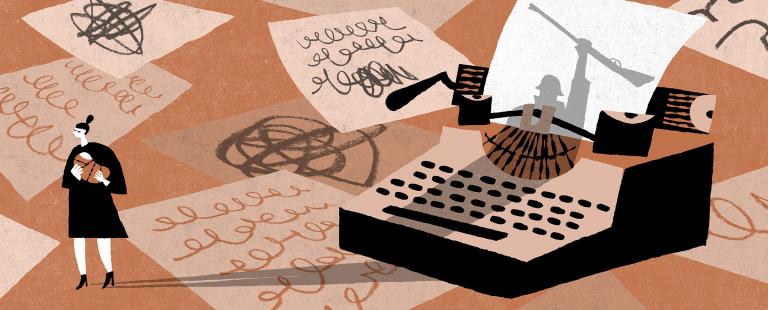Calligraphic Style in Pursuit of Expressiveness and the “Four Great Song Calligraphers
6 min readCalligraphers of the Jin dynasty pursued charms of penmanship; in the Tang dynasty they emphasized rules of calligraphy while in the Song dynasty they paid more attention to the expressiveness of scripts. All were reasonable pursuits. The calligraphic style in pursuit of expressiveness was dedicated to project one’s real interest and intention in the art of calligraphy.

This style became a main stream not only because calligraphers of the Tang dynasty had left little because the development of the Song culture laid a sound foundation for the maturity of the new style. For one thing, men of letters enjoyed a high social position and good financial status in the Song dynasty, which endowed them with high self-esteem. For another, the integration of Confucianism, Taoism and Buddhism made Chan reaucrats. And the Song calligraphers integrated the oncept of Chan into their calligraphy. In politics, they wanted to manage state affairs and govern the whole nation peacefully; and in art and literature, they were in pursuit of freedom and expressing themselves elegantly. No wonder the calligraphic style in pursuit of expressiveness gained its popularity calligraphy is not an exception. In the early Song dynasty, the art of calligraphy was still in the late Tang dynasty’s coat.
Only Li Jianzhong’s and Lin Bu’s works were a little bit different, especially Lin Bu’s. With his unique poems and sober calligraphy, Lin was the forerunner of the expressiveness-pursuing calligraphy. And Ouyang Xiu, who was considered as the leading figure of the Northern Song calligraphy and a strong proponent of poetry and essay renovation, had proposed some reasonable suggestions not only for the renovation of writing style, but also for calligraphic style. He had studied rubbing books of different kinds of ancient opinion, calligraphy was not to please people, it should be something that could% make oneself feel comfortable and he insisted that calligraphic style could be changed at any time.
His idea pioneered the formation of the expressiveness-pursuing calligraphic style in the late Northern Song dynasty. The true representatives for expressivene- calligraphy in the Northern Song dynasty were Su Shi, Huang Tingjian and Mi Fu. Su Shi (1037-1101), courtesy name (zi) Zizhan, and also called (had) Dongpo Jushi (resident of Dongpo), was born in Meizhou, Meishan county in Sichuan. In the history of Chinese culture, Su Shi was one of a few versatile geniuses He was not only a leading calligrapher who created a new calligraphic style, but also a member of the “Eight Masters of the Tang and Song Dynasties” and one of the “Three Su” (the other two were his father Su Xun and his brother Su Zhe). His poems were bold and unconstrained, the style turned out to be the top representative of the Song dynasty literature.
And the literati painting he initiated became a milestone in the history of Chinese painting. Besides, he was creative in daily life with the renowned “Dongpo pork”, “Dongpo ink”, and “Dongpo hat” which remain popula today. In calligraphy he made great achievement as well and is regarded as the number one among the Four Great Song Calligraphers the other three are Huang Tingjian, Mi Fu and Cai Xiang. Su Shi’s calligraphy was influenced by Ouyang Xiu profoundly. He learned from the “Two Wang” when he was young and from Yan Zhenqing in his middle age; he liked Li Yong when he was getting old. He had spent life time with the Jin and Tang calligraphy, yet finally worked out his own style. In calligraphic theory, he believed that calligraphy practice was not only to follow rules and regulations, but also to go beyond when one had grasped all so as to shake off the fetters left by the Tang dynasty. eally adored him. He once said that calligraphers should express later gene rarty. That is also why calligraphers of the Song dynasty as well a ions about their interest freely. His expressiveness-pursuing calligraphic style had a deep influence on calligraphers of the Song dynasty and later generations. He had left us many works, including Poems on Cold Food Festival in Huangzhou, paper copies now stored up in the Palace Museum in Taipei.
It is titled irsive Script in the World”. Besides, he had left Former Ode of Red d Epitaph to Huang Jidao. Huang Tingjian (1045-1105), courtesy name (zi) Luzhi, courtesy name (had) Shangu Daoren (Taoist in the Valley), was a native from Fenning, Xiushui county, in Jiangxi, and is commonly called “Valley Huang”. Huang’s calligraphy is different from that of the other three of the Four Great Song Calligraphers. He not only produced graceful regular script but also made great achievement in semi-cursive script and cursive script. His semi-cursiv script was guided by Su Shi in his early age, so it is close to the style of Su Shi’s calligraphy. Later he parted from his teacher and his calligraphic style changed as led in using brush and forming character structure in a radiate way, which en d his calligraphy with a particular style.

This change could also be seen in his calligraphic works in his old age. He worked very hard in practicing cursive script and tried various styles. His cursive script calligraphy was carefree and natural, especially his wild cursive script, which was wild, free and unrestrained, actually followed the calligraphy given by Zhang Xu and Huai Su in the Tang dynasty and was followed by Zhu Yunming and Wang Duo. He can be considered as an important figure that passed down wild cursive script after the Tang dynasty. His calligraphic works mainly include Li Bai’s Poems Recalling His Traveling Experience, All Friends Coming Home, Postscripts of Poems on Cold Food Festival in HuangZhou, Pine Wind Pavilion, etc.Mifu(1051-1107), courtesy name(zi) Yuanzhang, courtesy name(hao) Xiangyang Manshi and Lumen Jushi, was born in Xiangyang (now in Hubei). He He was born talented and so arrogant that he would never follow common customs. His official career was full of frustrations yet never worried him. His strong cleanliness and fondness of dress from the Tang dynasty revealed his special personality. Sometimes his behavior was so absurd, such as calling a stone “brother” and worshipping it, that people commonly called him “Crazy Mi”. Mi Fu was a calligrapher, painter, connoisseur and collector as well. He is one of the Four Great oat Song Calligraphers. He wrote essays yet never copied from previous man of letters; he wrote poems that were refined, elegant and distinct. His paintings, either landscape or persona had their uniqueness. Besides, he was also accomplished in authentication and calligraphy. He was good at all sorts of scripts especially semi-cursive style. Su Shi once praised Mi Fu for his excellent calligraphy was as good as that of Wang Xizhi.
Mi Fu also revealed in one of his rubbings that he had won the honor of the “Number one in the World” in his time. When he was young, Mi Fu learned calligraphy not only from Zhou Yue and Su Shi in his time, but also from Yan Zhenqing, Liu Gongquan, Ouyang Xun and Chu Suiliang in the Tang dynasty. His calligraphic copy work was so good that it was difficult to differentiate them from the authentic work. So he gained his reputation and left us his masterpieces such as Shu Su Tie, Hong County Peoms,etc. Mi’s calligraphy was quite influential in the Song dynasty. There were successors in his family. His eldest son Mi Youren followed his style yet was unable to be as creative and surpass his father. The last representative of the Four Great Song Calligraphers was Cai Xiang. Cai Xiang (10121067), courtesy name (zi) Junmo, was a native from Xianyou, in Fujian. He had been a government official and was titled “Zhong Hui (meaning loyal and intelligent)” after his death.
Cai Xiang was a faithful, honest and learned man. As one of the Four Great Song Calligraphers his calligraphy is as good as that of Su Shi, Huang Tingjian and Mi Fu. He learned calligraphy first from the Tang style and then from the Jin style, and finally blended the two together to create his own style. He was also good at all scripts, just like Yan Zhenging in his early years, yet lack of Yan’s’ boldness. His calligraph had the beauty of peace and elegance.he had left us his works such as About Tea, A Letter to Official Du Jun, and Ode to Cicada. Other than the Four Great Song Calligraphe mentioned above, there were some other excellent calligraphers such as Li Jianzhong, Zhao Ji, etc. They also contributed to the development of calligraphy of the early Song dynasty.









